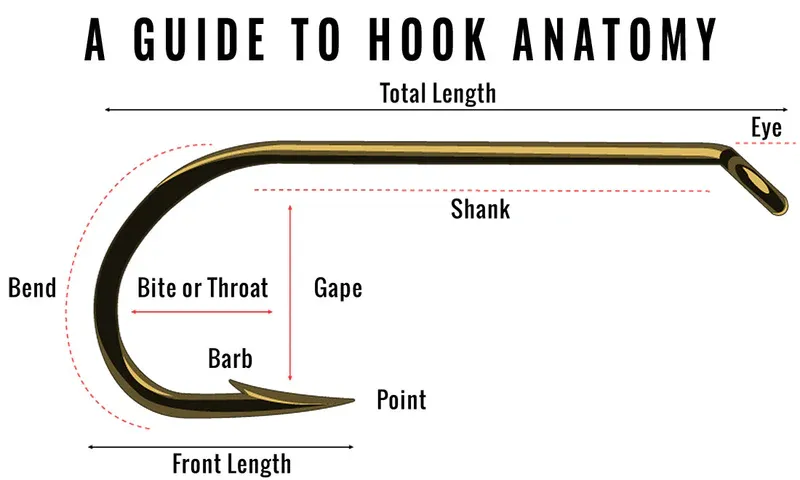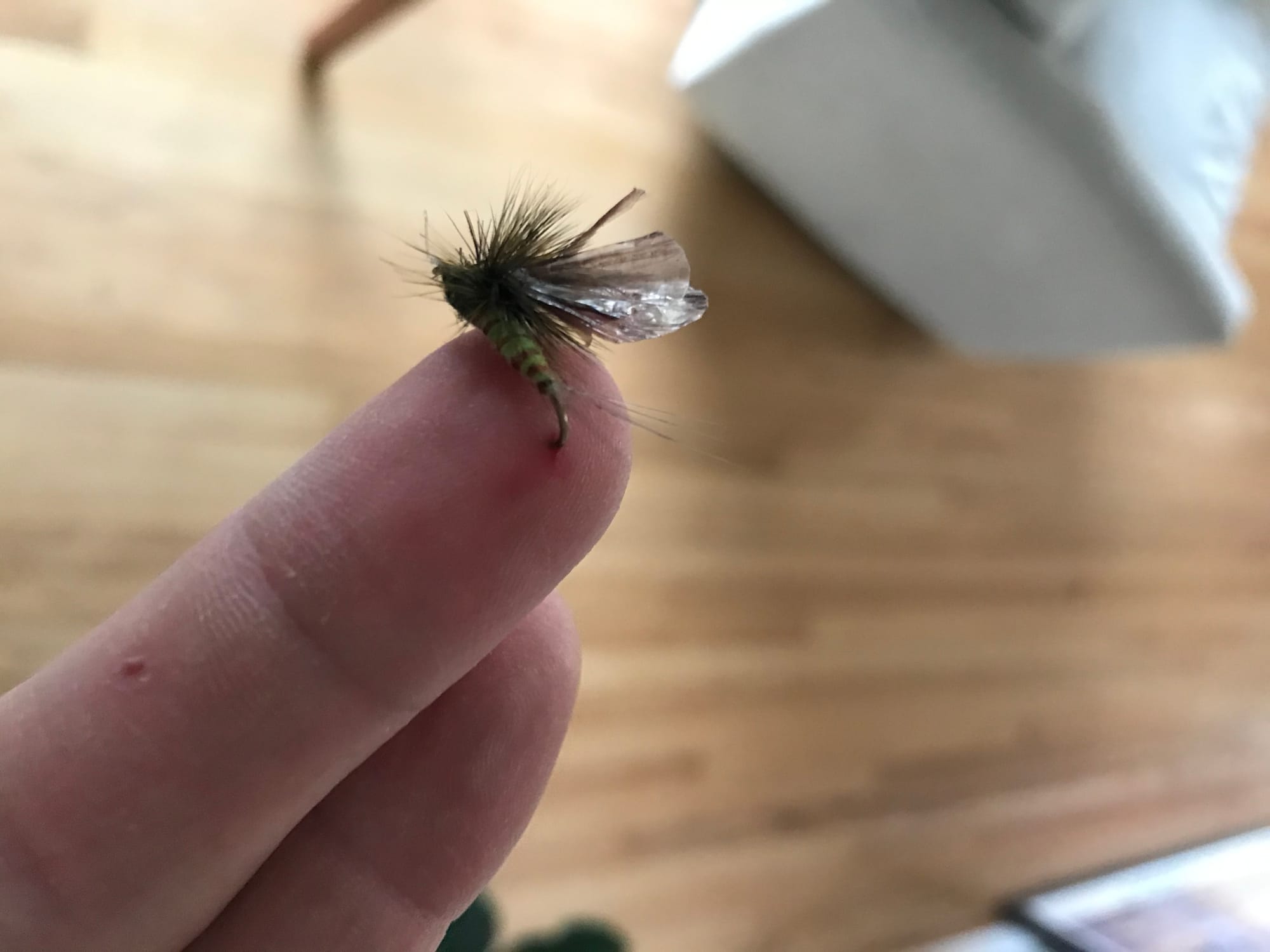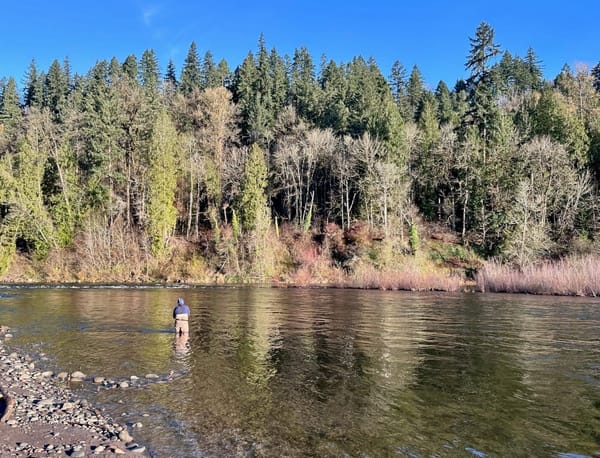Pain, pressure, and one hard pull: Hook removal done right
If you stick yourself rather than a fish, know how to get it out.

CFStrians: Content warning: This one's a little gnarly. If you're on the squeamish side, maybe skip. But, in the end, things wound up being less gnarly than they could have been. So, worth knowing what to do when it happens.
Our Summer Term intro class fished the ponds yesterday, and did great. A lot of firsts: first fish on a fly rod, on a dry fly, largemouth bass.
But, for me, there was a special first.
First major league hook removal. As in, "if we don't get this right, it's Urgent Care."
- How it all went down
- What you can do if you find yourself in that situation
- How to avoid this in the first place (ahem, barbless hooks)
It was just after lunch, and we had switched to using streamers. I'd given a little talk about why we use barbless hooks. And how that becomes an even more important factor with bigger flies. Our crew was warned.
As students fanned out across the complex, I took a few minutes to myself to get recombobulated, then sauntered off to follow them.
A man, little boy in tow, intercepted me as I walked down the main connecting path.
He was my age, wearing a well-worn sleeveless Dead tee that had seen better decades. The boy, about four, a big shock of thick curly hair.
"Are you the fly-fishing guy?" He had a chipped front tooth and a crooked smile that said he was in a jam, not just into jam bands.
I nodded. I suppose I was the fly-fishing guy.
He presented his left hand, in a sort of crooked greeting. In his right, a pair of rusty pliers. "I'm stuck pretty bad."
It sure wasn't anything resembling a fly. He had a big spoon hanging from a size 2 treble hook. Like the image at the top.
Said hook? Buried in the side of his thumb. We're talking a hook about the size of a quarter. Half-inch or so of hook plus barb.
My stomach tightened. I've stuck myself with flies. I've watched videos of hook removals before. But this was real: real flesh, real pain, real fallout if I botched it.
I'm not sure how he got it there. Starting an inquest wouldn't have been productive. (Nor would have documenting, which is why we don't have pictures.)
But here we were.
A quick tangent on hook anatomy
In fly-fishing, we use single hooks, like the one below. When the fish eats the fly, the hook is set. (Either by us, or by the fish.) And the point penetrates its mouth.
Here's the thing with barbs, though: When it goes in past the barb, it's much harder to pull out without tearing something. This is the same, whether it's a fish's mouth, or yours.

Now, imagine a lure with three of these hooks welded together, and you have a treble hook. The pointy problem we were dealing with.
Rejoining the hook removal action on the pathway
The bottom line came into focus. I was the only step between this guy and Urgent Care and a multi-hundred dollar bill.
On immediate diagnosis, we'd have to yank it out.
Technique here is counterintuitive. Common sense might say, if you have a hook in a meaty bit, like an earlobe, push the hook through. Then cut off the barb, slide it back out.
That might work in one or two places (your earlobes). In the rest of your body? That additional piercing is bad for business. It creates a bigger wound, and more tissue trauma.
"The only way out is through" is exactly the wrong strategy here.
And with our case, there was no pushing it through: the thumb bone and thumbnail are in the way. The hook has to come out the same way it went in.
To do that, we have to account for the barb, which prevents the fish from coming off the hook. So, we need to remove the hook by pulling it out. Enter the loop technique.
How it works is pretty simple, if somewhat magical: You take a loop of line, and put it under the hook. While applying pressure to the shank of the hook with one hand, around the eye, you yank on the loop. Hard. At just the right angle.

In theory, the dual pressure elements pop the hook out, with little tearing. The sudden force stretches the skin, and creates a channel through which the hook pops back out, without the barb catching. And it is painless. So they say.
In practice...well, in practice, you're standing with a nervous dad whose fishing trip with his kid just got serious. Who's dealing with a non-trivial amount of pain, so much so that he asked a total stranger to yank the hook out on some vague authority of being the fly-fishing guy.
I shared my opinion, that we'd have to pop it out with the loop. He agreed, and motioned his head over to the group of old guys on the disabled angler platform.
"Those guys said that's what they thought too, but they ain't never done it before, and don't want to."
Removing a fishing hook with a loop of line: a first timer's reflection
I leveled with him: I've never done this before either. But I've watched a fair number of videos in case it did happen. I know how it works, and feel confident about it working for us.
"Oh man, let's do it."
This guy was rough-and-ready. Ready to have the hook out of him. If I screwed it up, and sent him into even more pain, he might be understanding, and at least credit the effort. So we had our little contract in place.
My NOLS Wilderness First Responder training kicked in, and I started talking.
What's your name?
"Thomas."
What's your level of pain right now, Thomas, from 1-10?
"About a four....I'm just glad it wasn't the little guy."
You can say that again.
What's your name, little guy?
What are you fishing for?
Catch anything yet?
I tried to keep the questions coming, but forgot all the answers. My mind was racing through different ways the scenario could play out.
I didn't have heavy monofilament with me. The thickest line I had on me was 1X tippet, about a 12-13lb breaking strength. If I gave it a yank, the tippet might break before the hook popped off.
The spoon attached to the hook was flapping around, making the work area more crowded. Did we need to cut it off? Thomas still had his rusty pliers in his other hand, maybe that had a wire cutter thick enough to pop off the spoon. But that might be painful, and unnecessary.
And, we were standing in the middle of an asphalt path. I wanted to have absolute stability.
So, I pulled a 2' length of 1X off my spool and started tying it into a loop. My hands were way smoother than my nerves as I tied the loop, running through every way this could go wrong.
Wrong angle, too much force, and I'd tear his thumb open. Too little, and the hook stays put while the line snaps.
I suggested to Thomas we make our way to a picnic table nearby, to do the dang thing.
Doing the dang thing: hook removal using a length of fishing line
The picnic table was idea. I could stabilize Thomas' hand. Prevent any rotation or movement at the moment of truth.
As we set up, told him what was going to happen, to make sure he stuck with me and didn't move around.
He put his hand down, and I slid the loop under the hook. He was starting to get nervous. When you have a hook in you like that, it's both painful and unnatural. It hurts. But more than that, it feels like a strange itch, the odd sensation of unwanted foreign material in your body.
I had to readjust a few more times. I doubled the loop, to make sure it didn't break. And I put pressure on the hook eye buried in Thomas' thumb against the picnic table, and got ready to yank directly up.
OK Thomas, I said. Count backwards from 5, and I'll hit it on 1. He groaned, then started counting.
In those moments, I questioned everything. Was the technique right? How hard should I pull? Should I just drive him to Urgent Care?
I knew exactly where the Urgent Care was. I drove past it every time I came to the ponds for class. Each time, I gave it a slight nod. The sort of real-recognize-real of the hyper-vigilant safety worrier: Not today, Satan.
Maybe today was the day?
Nope, not today. I yanked on 1.5, slightly ahead of schedule.
And out it popped. I felt a no hint of resistance, the barb cleared clean. A metallic clank as the spoon hit the table.
But no muss, no fuss. No yelps of pain from Thomas. No reactive sobbing from junior. He showed me his thumb. A spot of blood, not much else.
How's the pain?
"None at all! Way less than going in!"
It's a small wonder anyone who severely hooks themselves ever goes fishing again. But that's just what Thomas did.
He said to the young kid, "Alright bud, let's get back to it," and headed down the bank. A few minutes later he flipped that spoon back into the pond.
I set out to see how the class was doing.
The old guys were looking different now.
"Are you a doctor?" one asked.
No, I just play one at the pond.

Ignore the headline, Bish from New Zealand has a great step-by-step guide to hook removal.

Prevent that tragedy: How to not hook yourself fishing
Sometimes it happens
Take it from me, you also have to accept that with all these hooks flying around, inevitably something is going to get stuck. Most times its stream-side vegetation, but one day your number will come up.
Intro alum Celeste sent this note from her Montana trip last week:
Caught a bunch of fish, learned a ton, saw some great wildlife, had a fabulous time and only hooked my partner in the face once😁
Her note was accompanied by this salivating beginning-of-the-day shot:
That, to me seems like a pretty good trade-off.
Luckily for us, it's easy to not have accidental hookups be gnarly. Here are a couple simple steps:
- Use barbless hooks
- Improve your casting
- Keep it covered
Use barbless hooks
One way to prevent having to do a complicated hook removal is to choose barbless hooks. If you have a barb on a fly, crimp it down. That way, if you poke yourself, you can just back the hook out.
Crimping barbs down is as simple as using a hemostat or pliers to crush the barb on the front length of the hook, behind the point.
Barbless hooks are also gentler on fish. So, if you're catch-and-release fly-fishing, there's really no reason to use barbs.
Many fly shops sell barbless flies. If you're tying your own flies, hooks that are marketed as "competition" come without barbs. Yes, it's a bit harder to land a fish on a barbless hook. But not by much.
Improve your casting
The other element that's going to help not hook yourself is to improve your casting.
Bad casts (caused by too much muscle, or power inappropriately applied, or just the wind) can send a tailing loop into your facial area. Cast considerately, don't just flail away out there with a big streamer.
Errant casts with big hooks can also break rods: a hook strike on a cast can introduce small chips in graphite rod shafts, which become big problems when the rod is put under stress.
Keep it covered
Hats and glasses, y'all.
Big brims and side-arms can prevent that hook impact.
And, haven't you heard? Fly-fishing fashion statements count now, too.
Last, but not least, if there was anyone I'd want pulling a hook out of my ocular area, it's the Deschutes Angler's John Hazel. He's done it a time or two.
Here he is demonstrating the technique in a very sensitive area:
How'd you get the hook out?
Subscribers: Tell us in the comments! 👇
Leaders ➰
Mindset 🧘♂️
Due to an enormous negative public response, Utah Senator Mike Lee has removed his attempts at selling off public BLM and Forest Service land from the budget reconciliation bill. Good job: your advocacy made a difference! Take this win, and think about what's next. (link)
Take a walk with Sam Stearns, the caretaker of Illinois' War Bluff Valley Wildlife Sanctuary (link)
Environment ⛰️
The Scientific Fly Angler checks in on how stream temperatures in the Driftless region fared during the recent heat wave, yet another strong reminder to bring a thermometer when you fish in the summertime. (link)
Technique 🤺
Yakoda Supply dishes on some Stillwater 101 tactics for your lake and pond trips this summer. (part 1, part 2)
Conservation 🌲
The New York Times' "50 States, 50 Fixes" highlights another pollution remediation solution, this one around harvesting rare earth metals from mine tailings in West Virginia. (link)
It's OK to let yourself off the hook.
— Some motivational poster somewhere.
𓆟 𓆝 𓆟






